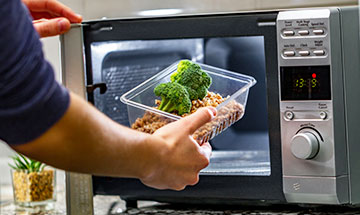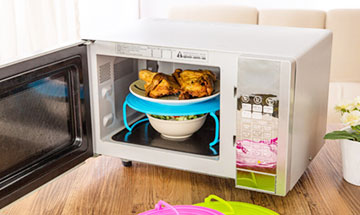Contents

We live in a modern world where plastic is one of the most frequently used materials. If we take a look around us, we’ll see that lots of objects in our house are plastic, including food containers and even baby’s stuff. We realize that this material might not be the safest for health; however, it’s challenging to quit using it.
We bet everyone puts plastic storage bins with food for heating up in the small microwave, although we know that it’s better to use glass or ceramic cookware.
“Can I microwave plastic?” – it’s one of the most frequent questions, and the quick answer is – no. But is it really so? Are there any exceptions?
We decided to do some online research and ask experts to have those answers. Today we are ready to share this information with you. Read on to find out whether you put at risk your health when you microwave plastic in a small microwave.
What Is Plastic?

Plastic is a material that consists of different compounds – synthetic, semi-synthetic, or organic, they are pliant and can be formed into various objects. Why is plastic bad? Because it contains such dangerous components as phthalates, bisphenol A (BPA), mercury, lead, cadmium, and dioxins. If this material burns, it releases toxin – dioxins, which can cause lots of dangerous consequences, e.g., plastic poisoning, or even cancer.
Of course, food containers which we use every day don’t contain all those compounds. However, the majority of storage bins do contain BPA and phthalates, which are often called hormone disruptors. They affect estrogen and testosterone and may cause reproductive and other health issues. Especially, BPA and phthalates are dangerous for fetuses and young children. Scientists are trying to replace these components, but the Environmental Working Group (nonprofit organization) claims that other chemicals – replacements for phthalates and BPA – weren’t tested enough. So, nobody knows for sure whether new chemicals are safe.
Experts recommend keeping away from recycled plastic with codes 3, 6, and 7, as they contain much of phthalates, styrene, and bisphenols. Do not heat it up in your microwave!
Can You Microwave Plastic
Even though this material contains harmful elements, it doesn’t necessarily mean that they’ll go into our food. Food containers are made to be stable, and they are not supposed to poison meals or drinks. So, can you put plastic in the microwave?
Director of the Center for Environmental Security (Biodesign Institute, Arizona State University) Rolf Halden says that the type of plastic, the amount of time you heat it in your small microwave, and the condition of the item influence the number of phthalates and BPA leaching into the meal or drink.
If you put into your convection microwave (or small microwave) old, battered container, you are at risk of having some of those hazardous substances. Also, don’t heat plastic up in a small microwave for too long – when it’s melting, it exudes harmful elements too. Here’s another reason not to heat up such containers: even the best small microwave enchafe unevenly so that some spots will be cold, some – too hot (and potentially dangerous).
Halden doesn’t recommend to heat fatty or creamy meals in plastic containers; such food absorbs much of toxic chemicals.
Our experts are often get asked certain questions concerning small microwaves and plastic. We are answering them here.
- Stylish black stainless steel with timeless design; Rated Voltage: 120V- 60Hz; Rated Input Power (Microwave): 1350W; Rated Output Power (Microwave): 900W
- Pre-programmed menu for 6 popular foods like popcorn, pizza, potato and more
- One touch start - quick access to start the microwave from 1 to 6 minutes cooking at full power
- Equipped with power-saving Eco mode, sound on/off option and child safety lock
- 900 watts with 10 power settings, clock, and kitchen timer
Can you microwave plastic tupperware?

Tupperware is marked as “microwave safe”, so you can heat food in it. However, we don’t recommend doing so because tupperware might be damaged in a small microwave.
Can you microwave plastic wrap?
If the wrap is labeled as “microwave safe”, you can microwave it. But you should know that USDA recommends avoiding such wrap to touch food while microwaving.
Can you microwave plastic bags?
Plastic bags, as well as grocery bags, mustn’t be microwaved. They melt easily and poison food or drinks. Although there are “microwave-safe“ items, we still wouldn’t recommend to heat them up in a small microwave.
Can you microwave styrofoam?
Styrofoam is a big no-no in small microwaves! It’s a type of plastic, which contains hazardous chemicals; they easily leach into food or drinks during heating.
How To Identify Plastic Type
Now when we know that some types of plastic are microwaveable, let’s find out which one we can heat up.
So, what plastic utensils can you put in your small microwave?

- Look for microwave-safe symbols on plastic containers: an image of a small microwave, squiggly lines, a dish set under radiation waves – these signs mean that such containers are safe to use in small microwaves.
- Utensils, which are marked as “greenware” or “biobased”.
- Containers, which are marked 1,2,4,5 can be put into a small microwave – they don’t contain BPA.
If you see these symbols or numbers, know that this type is a microwave-safe plastic and you can warm your food in it.
We, at mykitchenadvisor.com, stand for a healthy lifestyle and recommend using only safe utensils and appliances, including small microwaves. All in all, nothing is more important than a human’s health and life. We hope, our post will help you to make the right choice.
Take care!







